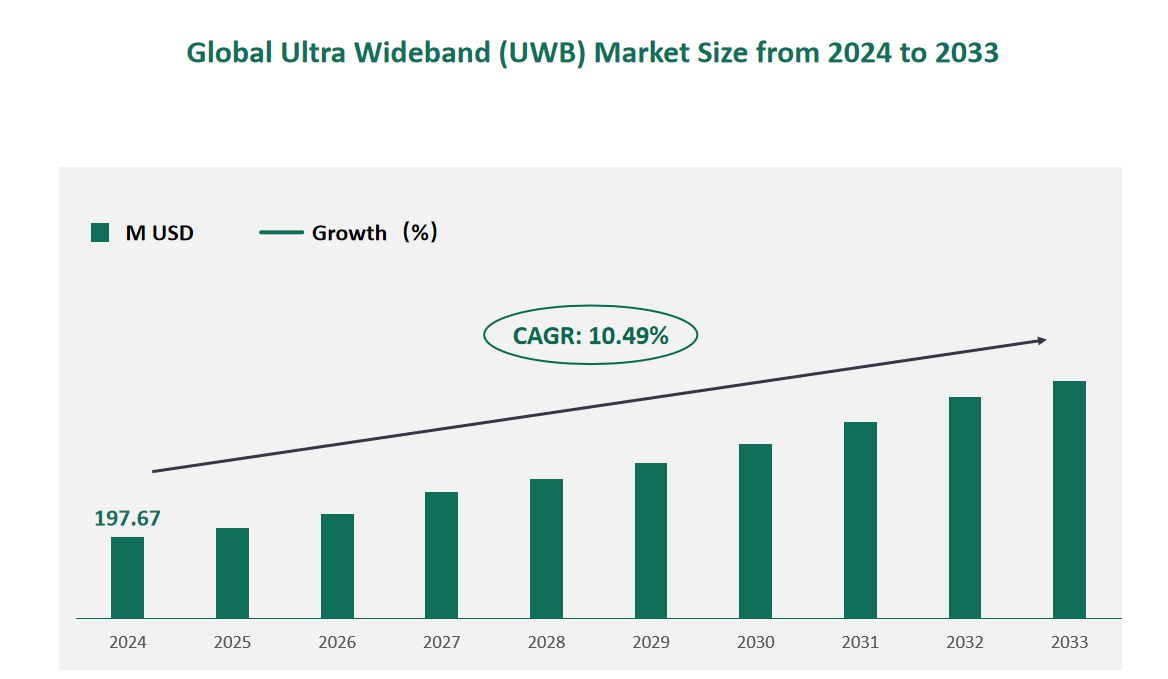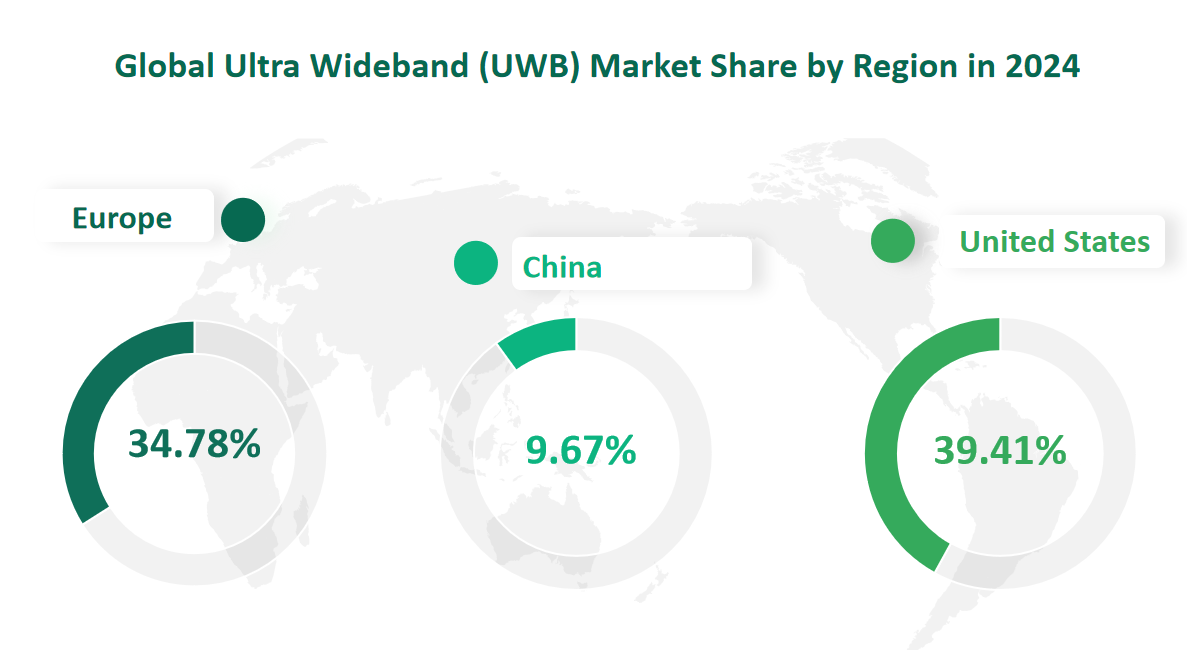1 Global Ultra Wideband (UWB) Market Size (Value) and CAGR (2024-2033)
The global Ultra Wideband (UWB) market value estimated to reach 197.67 million USD in 2024, with a Compound Annual Growth Rate (CAGR) of 10.49% from 2024 to 2033.
UWB, characterized by its high bandwidth, low power consumption, and the ability to operate efficiently in crowded environments, is an essential technology for short-range, high-bandwidth communications. It operates over a wide swath of the radio spectrum using very low energy levels and is renowned for its precise location tracking capabilities, making it ideal for wireless communication applications that demand high-quality services.
Figure Global Ultra Wideband (UWB) Market Size (M USD) and CAGR 2024-2033

2 Ultra Wideband (UWB) Market Growth Drivers and Challenges
The Ultra Wideband (UWB) market is influenced by a variety of drivers and challenges that shape its trajectory. Among the key drivers, the development of autonomous vehicle technology stands out. The automotive industry’s rapid progression towards smart and autonomous driving solutions has created a substantial demand for UWB technology, which is integral for precise vehicle positioning and safety.
UWB’s ability to provide high-precision location information surpasses traditional GPS capabilities, making it a critical component in the evolution of the automotive industry.
Government policies also play a significant role in propelling the UWB market forward. Regulations that promote the standardization and adoption of UWB technology, such as those supported by the FiRa Alliance, are instrumental in establishing a robust and interoperable ecosystem. This standardization is essential for ensuring the technology’s accuracy and security, particularly in challenging environments where UWB’s precision and robust RF connections can significantly enhance user experience.
Despite these drivers, the UWB market confronts several challenges. The industry’s competitive landscape is intensifying, with an increasing number of companies vying for market share. This competition extends beyond technological innovation to include market expansion and brand development. UWB’s limited range compared to other wireless technologies like 5G is a significant disadvantage, potentially restricting its application in large-scale or long-range scenarios. Additionally,
UWB’s susceptibility to interference from other wireless devices could impact its performance, particularly in dense urban environments where multiple signals compete for bandwidth.
The relatively nascent status of UWB technology also presents challenges. The market’s growth is hindered by the limited availability of UWB-compatible devices and infrastructure. This limitation affects the technology’s widespread adoption and necessitates significant investment in research and development to enhance its versatility and universality.
3 Emerging Market Trends and Consumer Preference Analysis in the Ultra Wideband (UWB) Market
The Ultra Wideband (UWB) market is witnessing emerging trends that are shaping its future. A significant trend is the increasing adoption of UWB technology in automotive manufacturing, industrial applications, medical-related applications, and the communications industry. China, as a vast emerging market, presents substantial market demand for UWB, driven by its growth in new energy vehicles and Industry 4.0. The development of telemedicine in China also brings significant opportunities for the UWB market, as it allows for remote patient monitoring and management, improving the efficiency and accuracy of medical services.
Consumer preferences in the UWB market are also evolving. Different industries have distinct requirements for UWB. The medical and industrial sectors demand high-precision positioning and communication capabilities, while the military industry requires high spatial resolution for radar systems. The communications industry prioritizes secure and high-volume data transmission, and the automotive industry needs high spatial resolution for obstacle avoidance, in addition to precise positioning.
4 Global Ultra Wideband (UWB) Market Size and Share by Type in 2024
The global Ultra Wideband (UWB) market is segmented into various types, each with its unique characteristics and applications.
Chip: UWB chips are semiconductor devices that enable short-range, high-bandwidth communications. They are expected to reach a market size of 53.33 million USD in 2024. These chips are known for their high precision and are integral to devices like smartphones for data transfer and communication.
Modules: Modules are the smallest independent packages that include a UWB chipset and supporting components. They are projected to have a market size of 73.37 million USD in 2024. Modules offer versatility and are used in a variety of applications, including device-centric and server-centric configurations.
Antennas: UWB antennas are designed for short-range, high-bandwidth applications with extremely low energy levels. They are anticipated to reach a market size of 38.82 million USD in 2024. These antennas are crucial for transmitting information over a wide bandwidth without causing interference with narrowband transmissions using the same spectrum.
Table Global Ultra Wideband (UWB) Market Size and Share by Type in 2024
Type | Market Size (M USD) 2024 | Market Share 2024 |
Chip | 53.33 | 26.98% |
Modules | 73.37 | 37.12% |
Antennas | 38.82 | 19.64% |
Others | 32.14 | 16.26% |
5 Global Ultra Wideband (UWB) Market Size and Share by Application in 2024
The Ultra Wideband (UWB) market is set to experience significant growth across various applications, with the technology being increasingly integrated into a range of industries. In 2024, the market size for each application is anticipated to reflect the diverse utility of UWB technology.
Smartphone: With the largest market share, the smartphone application is expected to reach a value of 78.43 million USD in 2024. UWB in smartphones enables precise location tracking and data transfer, providing a more accurate navigation and positioning experience than Wi-Fi and Bluetooth.
Industrial: The industrial application is projected to have a market size of 44.67 million USD in 2024. UWB is utilized in industrial settings for real-time positioning and optimization of production processes, enhancing asset efficiency and reducing loss.
Consumer Electronics: This application is expected to reach a market size of 23.58 million USD in 2024. UWB in consumer electronics allows for accurate device positioning and efficient interconnection, particularly in smart home devices for control and communication.
Automotive: The automotive application is forecasted to have a market size of 20.46 million USD in 2024. UWB technology in automobiles supports vehicle navigation and intelligent driving technologies, providing high-precision location information for autonomous navigation and obstacle avoidance.
Healthcare: The healthcare application is anticipated to reach a market size of 12.53 million USD in 2024. UWB is used in healthcare for real-time location tracking of patients and equipment, improving the speed and accuracy of medical services.
Military: The military application is expected to have a market size of 9.90 million USD in 2024. UWB technology is crucial for the precise location of soldiers, vehicles, and equipment, supporting combat decisions and enhancing military operations.
Table Global Ultra Wideband (UWB) Market Size and Share by Application in 2024
Application | Market Size (M USD) 2024 | Market Share 2024 |
Healthcare | 12.53 | 6.34% |
Automotive | 20.46 | 10.35% |
Industrial | 44.67 | 22.60% |
Consumer Electronics | 23.58 | 11.93% |
Military | 9.90 | 5.01% |
Smartphone | 78.43 | 39.68% |
Others | 8.08 | 4.09% |
6 Global Ultra Wideband (UWB) Market Size and Share by Region in 2024
The global Ultra Wideband (UWB) market is diverse, with different regions showcasing varying levels of market maturity and growth potential.
United States: With a market size of 77.90 million USD in 2024, the United States continues to be a significant player in the UWB market, driven by its strong technology sector and early adoption of advanced communication technologies.
Europe: The European market is projected to reach 68.74 million USD in 2024, with a strong focus on UWB technology in automotive and industrial applications, reflecting the region’s commitment to innovation and smart manufacturing.
China: The Chinese market is anticipated to have a size of 19.11 million USD in 2024. China’s rapid industrialization and investment in smart cities are driving the demand for UWB technology in various sectors, including consumer electronics and industry automation.
Japan: Japan’s market size is expected to be 10.23 million USD in 2024. The country’s focus on advanced technology and robotics is contributing to the growth of the UWB market, particularly in industrial and automotive applications.
India: India is projected to have a market size of 3.22 million USD in 2024. The growing IT and telecommunications sectors, along with the government’s push for digital India, are creating opportunities for UWB technology in the region.
Southeast Asia: The market size in Southeast Asia is expected to reach 3.84 million USD in 2024. The region’s economic growth and investment in digital infrastructure are fostering a conducive environment for the adoption of UWB technology.
Latin America: Latin America is anticipated to have a market size of 4.10 million USD in 2024. The region’s growing telecommunications sector and the need for improved connectivity solutions are driving the demand for UWB technology.
Middle East and Africa: The market size in this region is expected to be 5.73 million USD in 2024. The Middle East, in particular, is investing heavily in smart city projects, which are creating opportunities for UWB technology in various applications.
Figure Global Ultra Wideband (UWB) Market Share by Region in 2024

7 Major Players in Global Ultra Wideband (UWB) Market
7.1 Qorvo
Business Overview: Qorvo, established in 2015 and headquartered in Greensboro, North Carolina, USA, is a leading provider of innovative semiconductor solutions. The company specializes in connectivity and power solutions, serving a variety of high-growth areas in large global markets, including consumer electronics, smart home/IoT, automotive, electric vehicles, battery-powered devices, network infrastructure, healthcare, and aerospace/defense.
Product Offered: Qorvo combines product and technology leadership, systems-level expertise, and global manufacturing scale to address complex technical challenges. They offer a range of UWB modules that integrate innovative UWB chips with integrated UWB antennas and RF circuits, accelerating time to market and reducing development costs.
Financial Performance (2024): In 2024, Qorvo reported a revenue of 36.13 million USD, with a gross margin of 40.64%.
7.2 Apple
Business Overview: Apple, founded in 1976 and based in Cupertino, California, is a multinational technology company known for its design, manufacture, and marketing of consumer electronics, software, and online services. Apple is a household name, with a global presence and a reputation for innovation.
Product Offered: Apple’s foray into UWB technology began with the U1 chip, which uses UWB for spatial awareness in iPhones, allowing for precise device-to-device communication. This technology is integral to Apple’s ecosystem, enhancing user experience through features like AirTag tracking.
Financial Performance (2024): For the fiscal year 2024, Apple’s UWB segment generated a revenue of 23.73 million USD, with a gross margin of 40.42%.
7.3 NXP Semiconductors
Business Overview: NXP Semiconductors, established in 2006 and headquartered in Eindhoven, the Netherlands, is a global semiconductor company known for designing, manufacturing, and marketing a wide range of semiconductors and software for various applications, including mobile communications, consumer electronics, and security.
Product Offered: NXP Semiconductors plays a significant role in the UWB market, offering cutting-edge UWB chips that are integrated into high-end devices and vehicles. Their technology enables secure, hands-free access and precise indoor navigation, catering to automotive, industrial, and consumer markets. NXP’s UWB products include advanced chips that support a range of applications, from secure access control to real-time indoor positioning, showcasing the company’s commitment to innovation in wireless technology.
Financial Performance (2024): NXP Semiconductors achieved a revenue of 18.55 million USD in 2024, with a gross margin of 36.29%.

